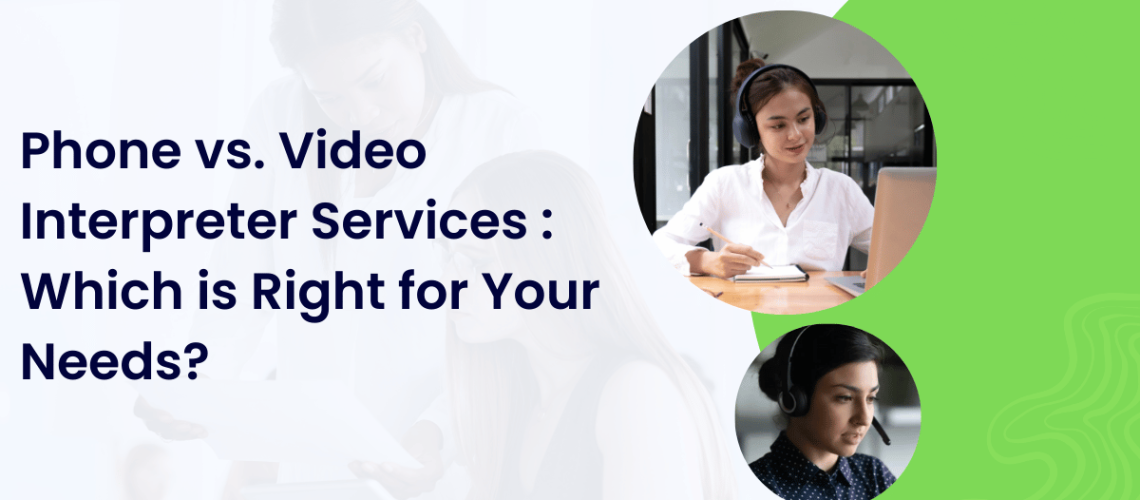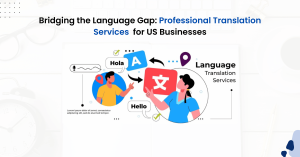In today’s interconnected world, clear communication across languages has become more important than ever. Whether you’re managing global business relationships, delivering healthcare, or handling legal affairs, being able to communicate effectively is essential. Interpreter services play a critical role in breaking down language barriers, acting as a bridge between different languages and cultures.
With advancements in technology, remote interpretation has evolved, offering two key methods: phone interpretation and video interpretation. Both approaches have distinct features and advantages, and selecting the right one depends on your specific needs and circumstances.
This guide provides a detailed look at remote interpretation, focusing on the differences between phone and video services. It highlights their strengths, limitations, and practical applications to help you determine which option works best for your situation. From understanding the technical requirements to recognising how they fit into various industries, this guide will equip you with the information needed to make the best choice for your communication needs.
A Closer Look at Remote Interpretation Services
Remote interpretation services have transformed communication, allowing individuals speaking different languages to connect seamlessly in real-time, regardless of location. These services have become essential in today’s interconnected world, removing physical barriers to effective communication.
What Are Remote Interpretation Services?
Remote interpretation involves a trained interpreter facilitating conversations between speakers of different languages without being physically present. The interpreter translates spoken or signed language in real-time, ensuring clear and effective communication.
This approach has grown out of the need for fast, reliable language support in diverse settings. By eliminating the logistical complexities of on-site interpretation, remote services provide greater accessibility and cost-effectiveness for users around the globe.
The Evolution of Remote Interpretation
Remote interpretation began with telephone-based solutions that offered a simple and convenient way for interpreters to assist over a phone call. This method gained widespread adoption due to its ease of use and accessibility.
The advent of video technology took remote interpretation a step further by incorporating visual elements. This was particularly beneficial for sign language interpretation and scenarios where non-verbal cues like facial expressions and gestures are critical to understanding.
Why Remote Interpretation Matters Today
Effective cross-language communication is vital in a world that’s more connected than ever. Remote interpretation services play a significant role in various sectors, including:
- Business: Enabling international trade and partnerships by bridging language gaps.
- Healthcare: Supporting communication with diverse patient populations to deliver better care.
- Legal Systems: Ensuring fairness and accessibility in legal proceedings for non-native speakers.
- Education: Assisting schools and universities in working with multilingual students and families.
- Emergency Services: Facilitating critical communication in crises to save lives.
Understanding Phone Interpretation Services
Phone interpretation has long been a reliable solution for overcoming language barriers, and providing quick and effective communication support. Here, we explore how phone interpretation works, its key features, and the scenarios where it offers the greatest benefits.
How Does Phone Interpretation Work?
Phone interpretation is a simple process that connects people who speak different languages through a three-way phone call. Here’s how it typically unfolds:
- Starting the Call: The client dials the phone number provided by the interpretation service.
- Choosing the Language: The client specifies the two languages needed for interpretation (e.g., English and Spanish).
- Connecting to an Interpreter: The system connects the client with a qualified interpreter fluent in the chosen languages.
- Three-Way Communication: The interpreter joins the call to facilitate the conversation between the two parties.
- Real-Time Translation: The interpreter listens to each speaker and provides a verbal translation, ensuring smooth and clear communication.
Key Features of Phone Interpretation
Phone interpretation services are widely used because they offer unique advantages, including:
- Accessibility: Services are available 24/7 and can be accessed from anywhere with a phone connection.
- Speed: Interpreters can usually be connected within seconds or minutes, ensuring minimal wait times.
- Privacy: The lack of visual interaction can be helpful for sensitive discussions.
- Language Options: Many providers offer interpretation in hundreds of languages and regional dialects.
- Affordability: Phone interpretation is often more cost-effective than video or in-person services.
What Do You Need for Phone Interpretation?
One of the standout benefits of phone interpretation is its simplicity. Users only require:
- A working telephone (landline or mobile)
- A stable phone connection
- The service provider’s contact number
This low-tech setup makes phone interpretation accessible for a wide range of individuals, businesses, and organizations, regardless of their resources or technical expertise.
When Is Phone Interpretation Most Useful?
Phone interpretation is ideal for situations where immediate, no-frills language support is required, such as:
- Emergency services
- Customer support hotlines
- Medical consultations
- Legal advice over the phone
Understanding Video Interpretation Services
Video interpretation services bring a new dimension to remote language support, combining the ease of remote access with the power of visual communication. Here’s an in-depth look at how video interpretation works, its key features, and the scenarios where it’s most effective.
How Video Interpretation Works
Video interpretation uses modern videoconferencing tools to bridge language gaps in real-time. Here’s a step-by-step guide to how it operates:
- Setting Up the Call: The client uses a device such as a computer, tablet, or smartphone to initiate a video call on a supported platform.
- Choosing the Languages: The client specifies the two languages for interpretation.
- Connecting with an Interpreter: A trained interpreter fluent in the selected languages joins the video call.
- Visual Interaction: All participants can see one another, allowing for verbal and non-verbal communication.
- Real-Time Interpretation: The interpreter translates the conversation in real-time, ensuring clarity and smooth interaction.
Unique Features of Video Interpretation
Video interpretation offers distinct advantages that make it ideal for specific situations:
- Visual Communication: Body language, facial expressions, and gestures can be interpreted, enhancing understanding.
- Support for Sign Language: Critical for individuals who rely on sign language for communication.
- Document Sharing: Visual aids or documents can be shared during the session for better clarity.
- Multi-Party Calls: Can connect participants from multiple locations on the same call.
- Recording Options: Some platforms allow sessions to be recorded (with permission) for later review.
What You Need for Video Interpretation
Unlike phone interpretation, video interpretation requires some basic technology:
- A device with video capabilities, such as a computer, tablet, or smartphone
- A stable internet connection with adequate speed
- A video conferencing platform like Zoom, Microsoft Teams, or Cisco Webex
- A webcam and microphone (built-in or external)
- Basic knowledge of using video conferencing tools
While these requirements are more advanced, they are generally accessible to most users with modern technology.
When to Use Video Interpretation
Video interpretation is particularly effective in situations where visual communication adds value, such as:
- Healthcare: For patients needing to express or understand non-verbal cues during consultations.
- Legal Proceedings: Where clarity and accuracy of communication are essential.
- Education: For lessons, workshops, or discussions with multilingual participants.
- Business Meetings: When connecting with global teams or partners.
- Sign Language Interpretation: To provide accessible communication for the deaf or hard-of-hearing community.
Comparing Phone and Video Interpretation Services
Choosing between phone and video interpretation depends on understanding the unique benefits and limitations of each. Here’s a detailed comparison to help you decide based on your requirements.
1. Accessibility and Convenience
Phone Interpretation
- Simple to access; all you need is a telephone.
- Quick to initiate, often within seconds.
- Can be used anywhere with phone coverage, making it ideal for emergencies or on-the-go needs.
- Works well in areas with limited or no internet connectivity.
Video Interpretation
- Requires a device with video capabilities (like a smartphone, tablet, or laptop) and an internet connection.
- Setup takes slightly more time compared to phone interpretation.
- Dependent on a stable internet connection for smooth communication.
- Best suited for scheduled sessions in a fixed location.
2. Quality of Communication
Phone Interpretation
- Limited to audio; non-verbal cues such as body language are missed.
- Challenging to use in noisy environments.
- Relies on clear speech and consistent speaking pace.
- Best for straightforward verbal communication.
Video Interpretation
- Offers verbal and non-verbal communication, including facial expressions and gestures.
- Enables lip-reading and enhances clarity for participants.
- More personal and engaging, fostering better understanding.
- Ideal for scenarios requiring visual aids or demonstrations.
3. Language Coverage
Phone Interpretation
- It provides a broader selection of languages, including rare dialects.
- It is easier to find interpreters for less common language pairs.
- A versatile option for global communication needs.
Video Interpretation
- Typically focuses on widely spoken languages.
- Essential for sign language interpretation, where visual interaction is crucial.
- May have limitations in supporting rare languages.
Cost Considerations
Phone Interpretation
- More budget-friendly than video options.
- Often billed by the minute, offering flexibility in usage.
- Requires no additional equipment or setup costs.
Video Interpretation
- Generally more expensive due to the need for advanced technology.
- May involve costs for video conferencing tools or devices.
- Often billed in longer time blocks, which may increase costs.
Which Option is Right for You?
When deciding, consider the specific needs of your situation:
- Use phone interpretation for urgent, on-the-go, or cost-sensitive needs.
- Opt for video interpretation when visual communication, sign language, or a more personal connection is required.
Conclusion
As we’ve explored throughout this comprehensive guide, the choice between phone and video interpretation services is not a one-size-fits-all decision. Each option offers unique advantages and considerations that must be weighed against your specific needs, resources, and circumstances.
Phone interpretation services excel in accessibility, immediacy, and cost-effectiveness. They’re ideal for situations requiring quick language support, especially in areas with limited technological infrastructure. The simplicity of phone interpretation makes it a versatile solution for a wide range of scenarios, from emergency services to basic customer support.








